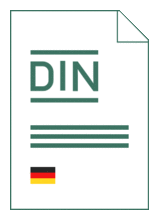
Standard [WITHDRAWN]
DIN 38409-46:2011-08
German standard methods for the examination of water, waste water and sludge - Parameters characterizing effects and substances (group H) - Part 46: Determination of purgeable organic carbon (POC) (H 46)
- German title
- Deutsche Einheitsverfahren zur Wasser-, Abwasser- und Schlammuntersuchung - Summarische Wirkungs- und Stoffkenngrößen (Gruppe H) - Teil 46: Bestimmung des ausblasbaren organischen Kohlenstoffs (POC) (H 46)
- Publication date
- 2011-08
- Original language
- German
- Pages
- 16
- Publication date
- 2011-08
- Original language
- German
- Pages
- 16
Product information on this site:
Quick delivery via download or delivery service
All transactions are encrypted
This document has been prepared by Working Group "POC" NA 119-01-03-01-20 AK of NA 119-01-03 AA "Wasseruntersuchung" ("Water analysis") at the Water Practice Standards Committee (NAW) which are funded by the Länderfinanzierungsprogramm "Wasser, Boden und Abfall" (federal funding programme "Water, soil and waste"). This document specifies a method for determining the organic carbon content which is expelled from an aqueous sample (POC) under the described conditions. The method is applicable for the examination of aqueous samples where it is used in particular for examination of groundwater, wastewater and landfill seepage water. The method also applies to samples with suspended matter. Purgeable organic carbon is a conventional analytical parameter used for control of water quality. It is a measure for the carbon content of the organic compounds contained in an aqueous sample which are expelled under specified conditions. It is therefore a measure for the concentration of organic compounds having the potential to transform from the aqueous to the gaseous phase. The real extent of stripping of a substance, for example, from wastewater in the sewer system or the wastewater treatment plant cannot be determined using the measurement method as many parameters have an influence on the transfer of substances, for example, temperature, state of flow, retention time and air exchange rate. POC does not provide information about the type of purgeable compounds. The final determination of carbon dioxide is performed with various procedures, for example, infrared spectrometry or electrical conductivity. The procedure using combustion and infrared spectrometry has been validated within the framework of an interlaboratory test. Other procedures are considered suitable as long as they meet the specifications of 10.3.
This document has been replaced by: DIN 38409-46:2012-12 .
